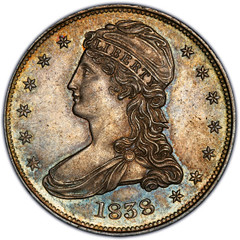
PREV ARTICLE
NEXT ARTICLE
FULL ISSUE
PREV FULL ISSUE
MONEY IN EVERYDAY EXPRESSIONS
On February 25, 2016 Coin Update published an excerpt from Ken Bressett's book, Milestone Coins: A Pageant of the World’s
Most Significant and Popular Money. Here it is! -Editor
Few people know that today’s gazette comes from a Venetian coin of the 17th century. The coin was a 2-soldi copper piece that was called a “gazzetta.” This was a diminutive of the Latin word gaza, meaning “treasure.” These coins are about one inch in diameter and have the lion of Venice surrounded by the words SAN MARC VEN *II* on the obverse, and DALMA ET ALBAN on the reverse. Shortly after the gazzetta was first made for circulation, Venice commenced to publish an official newspaper dealing with public affairs. The paper sold to the citizens for one gazzetta, and before long the paper itself became known as the gazzetta. The name stuck and has become synonymous with publications ever since. The term buck, meaning a dollar, has its origin with the American Indians and early settlers who valued deerskins as a medium of exchange. A copperhead was a person in the Northern states who sympathized with the South during the Civil War, and got the name from the Civil War tokens that were made of copper and used extensively in the North. The word jitney, for a small bus, was originally a token, and later the British coin that was the price of a fare. “Weird as a three-dollar bill” got its reputation when the government first made greenback bills in 1861 but neglected to make an anticipated note of that denomination. When the public learned that there was no such thing, anything odd or unusual was compared to the non-existing money. Pin money was originally tattered and repaired paper money of colonial America that was given to a housewife to spend for household items. It was often so worn that it had to be sewn or held together with pins, and unworthy of use by the man of the house. In England the admonition “Spend a penny” means do not be frugal—just do it and spend the money. The expression originated with the public toilets that charged a penny toll to open the lock on the doors. “Another day, another dollar” meant just that in the early 20th century, when wages in America were one dollar for a day’s work. This essay is excerpted from Kenneth Bressett’s popular book, Milestone Coins: A Pageant of the World’s Most Significant and Popular Money.
I didn't know that about the word 'gazette'. Thanks, Ken! -Editor
To read the complete article, see:

Wayne Homren, Editor The Numismatic Bibliomania Society is a non-profit organization promoting numismatic literature. See our web site at coinbooks.org. To submit items for publication in The E-Sylum, write to the Editor at this address: whomren@gmail.com To subscribe go to: https://my.binhost.com/lists/listinfo/esylum All Rights Reserved. NBS Home Page Contact the NBS webmaster 
|
